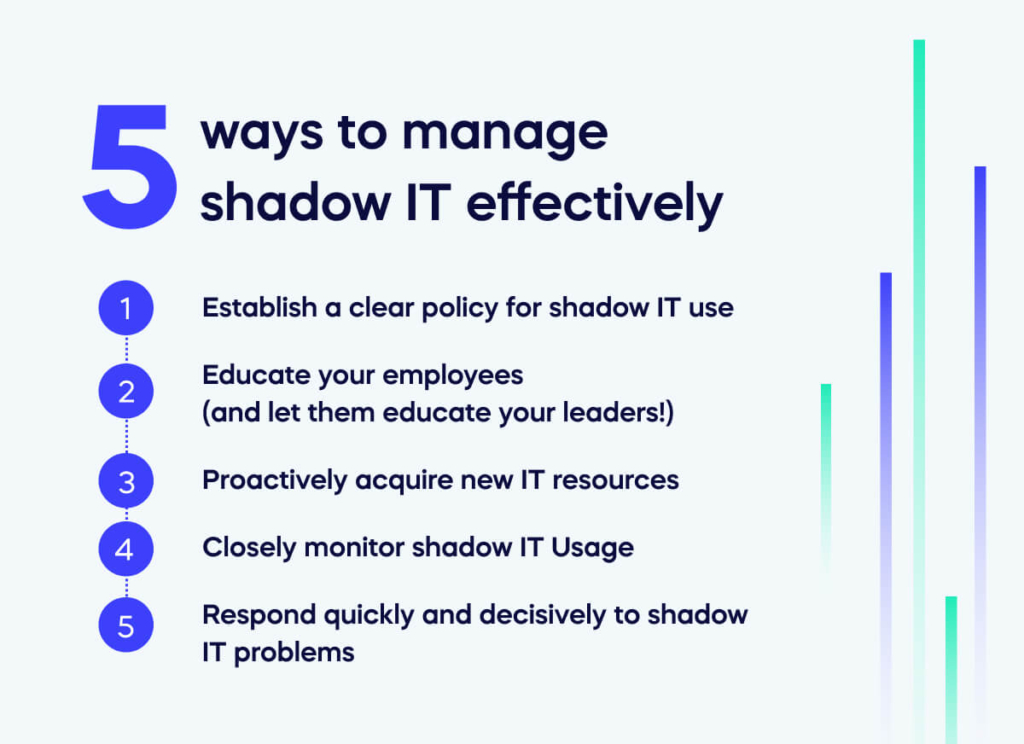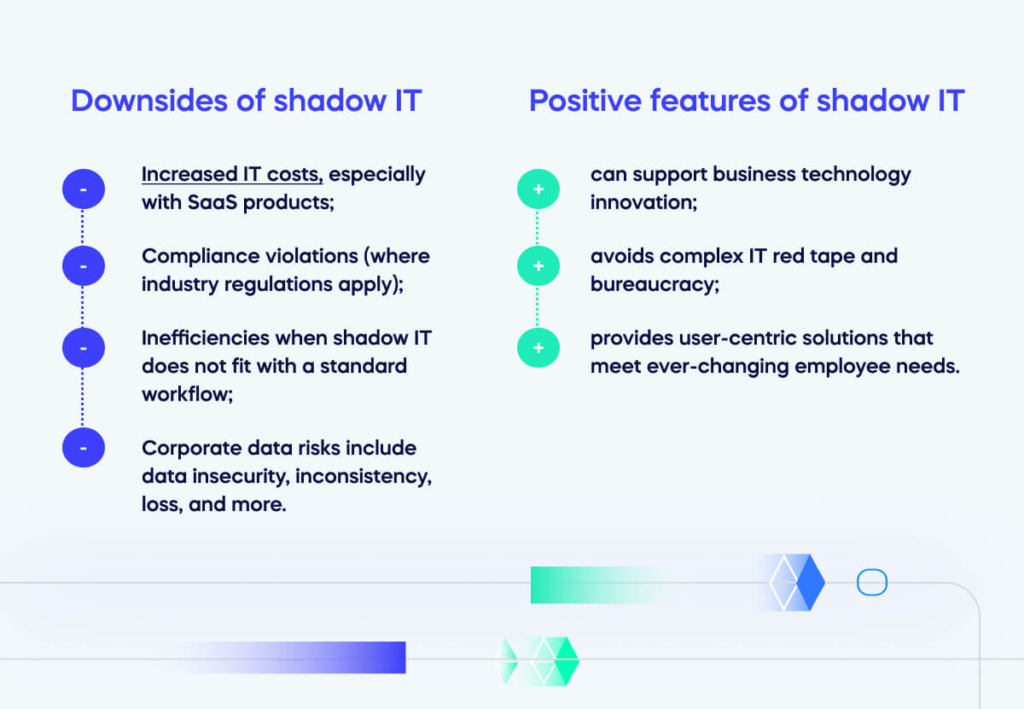In a business context, when employees use unauthorized technology, we call it shadow IT.
Shadow IT can be surprisingly problematic for IT managers.

In our view, the key actions for strategically managing shadow IT are:
- Establish a clear policy for shadow IT use
- Educate your employees
- Proactively acquire new IT resources
- Closely monitor shadow IT Usage
- Respond quickly and decisively to shadow IT problems
Shadow IT is not a new problem. However, as new technologies emerge, predicting, controlling, and maximizing shadow IT is challenging. For example, Gartner has recently indicated that as we move into 2024, shadow AI’s challenges for trust, risk, and security management will likely be major issues.
In this short article, we will remind you about the meaning of shadow IT and introduce five of the most important ways of managing this technology. If you have good management practices, there’s no need to worry about employees using shadow IT.
As we’ll see, shadow IT can do a major service to your company.
What is shadow IT, and why is it risky?
Shadow IT is any hardware or software used in a business that central management has not approved. Shadow IT (sometimes called rogue IT) happens easily in today’s digital-first world. For example, employees may use their own cloud storage systems, messaging applications, smartphones, ChatGPT, or SaaS subscriptions to complete business-related tasks.
Employees use shadow IT because it is convenient. However, they may not consider the wider implications of using these systems. To manage shadow IT effectively, we must appreciate the pros and cons of using unsanctioned assets.

There are many downsides of shadow IT. IT managers lose sleep over shadow IT because it can lead to:
- Increased IT costs, especially with SaaS products;
- Compliance violations (where industry regulations apply);
- Inefficiencies when shadow IT does not fit with a standard workflow;
- Corporate data risks include data insecurity, inconsistency, loss, and more.
On the other hand, shadow IT also has positive features. For example, shadow IT:
- can support business technology innovation;
- avoids complex IT red tape and bureaucracy;
- provides user-centric solutions that meet ever-changing employee needs.
So, Shadow IT is both a threat and an opportunity. That’s why effective shadow IT management is so important. With the right approach, IT leaders can reduce the risks while capitalizing on the benefits.
Indeed, managing shadow IT can give businesses a strategic advantage. As the Gartner analyst Mbula Schoen explained in 2021, shadow IT can be a useful way to enhance organizational technology capabilities.
Five ways to manage shadow IT effectively
As the previous section shows, managing shadow IT effectively is a balancing act.
On one hand, it offers the promise of innovation, agility, and a responsive approach to the ever-evolving technology needs of employees.
On the other hand, the uncharted territory of unapproved software and technology brings its own set of challenges. While it’s essential to empower employees to be agile and adaptable, it’s equally crucial to maintain control and security within the organization.
We present five essential steps for managing shadow IT to mitigate potential security risks, protect sensitive company data, and ensure secure file sharing.
Establish a clear policy for shadow IT use
A clear and well-communicated policy is very valuable to help staff understand what they can and cannot do with shadow IT.
This policy should explicitly outline which software and technology solutions are approved for use and which are not. If shadow IT has serious consequences for your company, the policy can also outline disciplinary outcomes for non-compliance.
This proactive approach sets expectations and fosters a culture of transparency and accountability.
A policy helps the IT department to better monitor, respond to, and mitigate potential risks associated with unauthorized technology usage. A clear policy is a foundational step in mitigating risks, maintaining control over the technology landscape, and fostering a more secure and compliant IT environment.
Educate your employees (and let them educate your leaders!)
Education is a cornerstone of effective shadow IT management.
Ensuring that employees understand the potential risks and consequences of using unauthorized software or technology is vital.
Traditional training techniques in meetings, workshops, and regular communication will make them aware of the organization’s IT policies and the approved solutions.
But here’s a twist. Consider letting employees, who may be more familiar with the latest technology trends, educate your leaders about innovative and efficient solutions.
This way, education plays a part in a wider culture of collaboration and community. Gartner’s guidance for Shadow IT suggests that co-learning communities for IT workers and project communities are especially important. By educating employees and allowing them to contribute their insights, organizations can harness the collective wisdom of their workforce to identify and implement technology solutions that are efficient and aligned with company policies.
Proactively acquire new IT resources
Don’t only acquire technology by reacting to employees’ adoption of unauthorized software and technology.
Instead, take the lead in researching, selecting, and implementing new solutions. Engage with employees to understand their needs and preferences, then invest in IT resources that align with those requirements and meet security and compliance standards.
By taking this approach, organizations can harness the benefits of innovation and agility while reducing the temptation for employees to resort to shadow IT.
Proactive IT resource acquisition aims to strike a balance between addressing employee needs and maintaining control over the technology environment, ultimately fostering a more secure, compliant, and efficient IT landscape.
Closely monitor shadow IT Usage
Policy, education, and acquisition work better if you closely monitor shadow IT usage.
A Digital Adoption Platform (DAP) can provide valuable insights into your organization’s workings. It persistently tracks, identifies, and reports all software and technology use. This crucial data from a DAP helps understand why employees opt for these alternatives.
This approach helps IT departments pinpoint potential risks and enables them to proactively address employee needs by integrating authorized solutions or educating staff about existing tools.
Continuous surveillance provided by a Digital Adoption Platform (DAP) can effectively manage the emerging threat of shadow IT, particularly shadow AI. As per a Gartner report published towards the end of 2023, the initial step to prevent AI security breaches is to diligently monitor AI.
The report suggests that implementing a system designed to systematically log and approve access to AI models and verify their actual usage will yield long-term benefits.
Respond quickly and decisively to shadow IT problems
Even with the best policies in the world, shadow IT problems can easily arise. Perhaps one department has been using personal devices too much, or sensitive data was stored on a personal Dropbox account. And now, there’s a problem.
Swift and decisive responses to shadow IT problems are crucial. Timely action can prevent minor issues from escalating into major security breaches. IT departments should establish a clear incident response plan, which includes steps to identify, isolate, and address unauthorized technology usage.
When security issues arise, it’s important to investigate the root causes and take immediate measures to mitigate risks. By responding promptly, organizations can maintain the integrity of their data and systems, reduce vulnerabilities, and demonstrate their commitment to safeguarding sensitive information.
Manage shadow IT strategically, not reactively
Managing shadow IT is a multifaceted challenge. It cuts across many aspects of the information technology infrastructure – from cloud services to portable devices to software.
The best way to address this complex situation is with a systematic approach. Policy development, establishing an agile corporate network, and other measures all clearly contribute to positive outcomes.
While the issue may come from a simple source, a resolution may require robust security measures, such as outright bans on personal device usage.


